HONDA CIVIC HYBRID 2013 9.G Owners Manual
Manufacturer: HONDA, Model Year: 2013, Model line: CIVIC HYBRID, Model: HONDA CIVIC HYBRID 2013 9.GPages: 346, PDF Size: 6.95 MB
Page 271 of 346
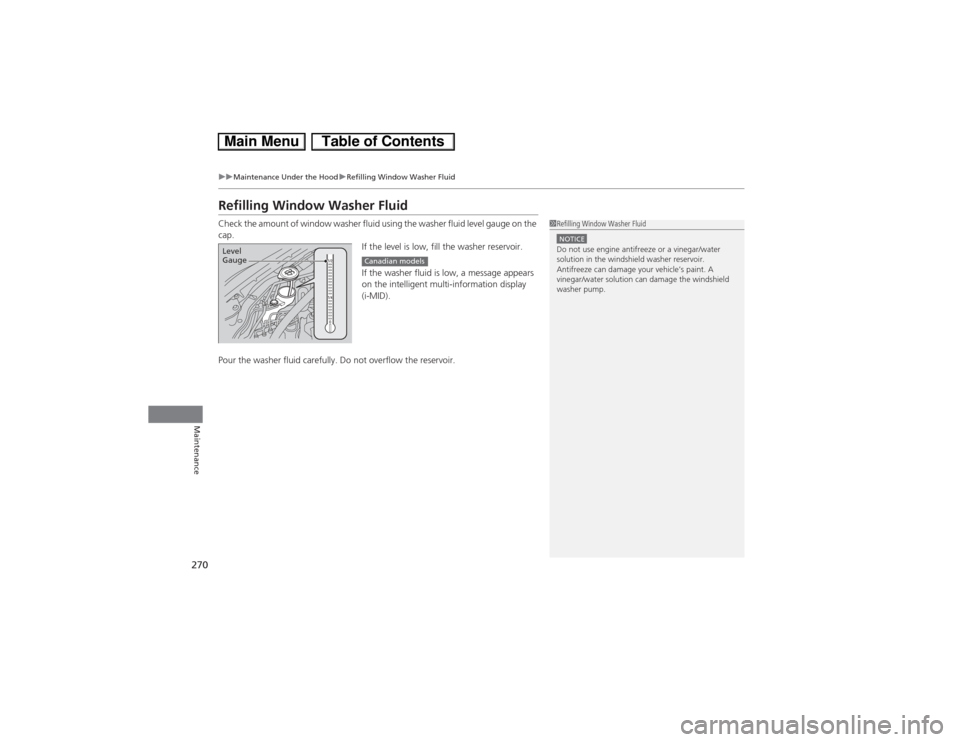
270
uuMaintenance Under the HooduRefilling Window Washer Fluid
Maintenance
Refilling Window Washer FluidCheck the amount of window washer fluid using the washer fluid level gauge on the
cap.
If the level is low, fill the washer reservoir.
If the washer fluid is low, a message appears
on the intelligent multi-information display
(i-MID).
Pour the washer fluid carefully. Do not overflow the reservoir.
1Refilling Window Washer FluidNOTICEDo not use engine antifreeze or a vinegar/water
solution in the windshield washer reservoir.
Antifreeze can damage your vehicle’s paint. A
vinegar/water solution can damage the windshield
washer pump.
Level
Gauge
Canadian models
Page 272 of 346
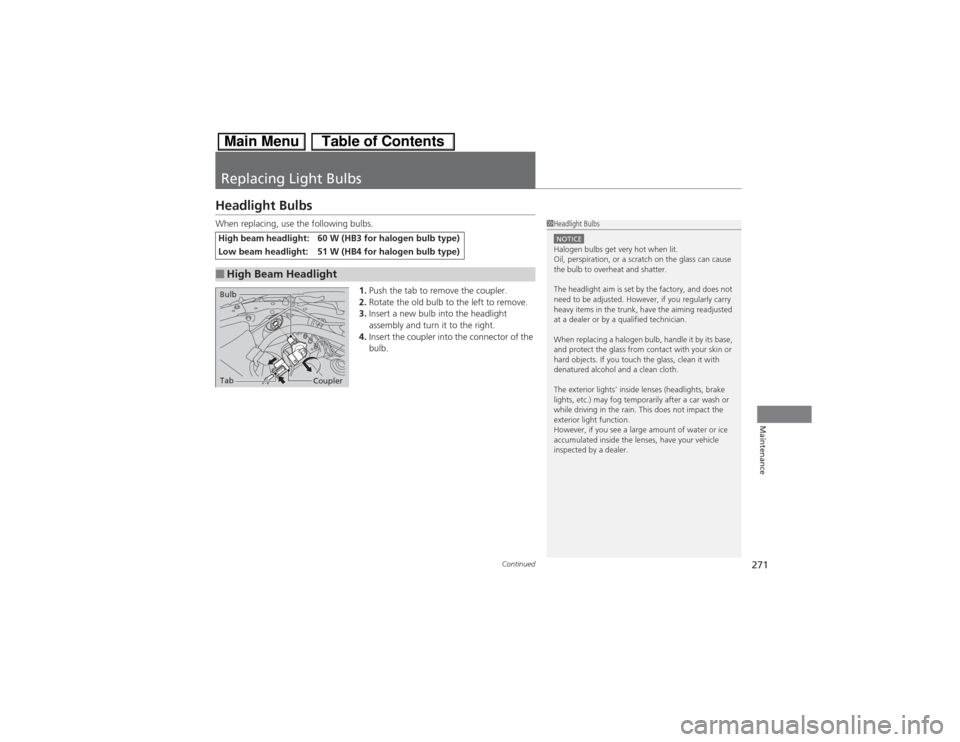
271
Continued
Maintenance
Replacing Light BulbsHeadlight BulbsWhen replacing, use the following bulbs.
1.Push the tab to remove the coupler.
2.Rotate the old bulb to the left to remove.
3.Insert a new bulb into the headlight
assembly and turn it to the right.
4.Insert the coupler into the connector of the
bulb.High beam headlight:
60 W (HB3 for halogen bulb type)
Low beam headlight:
51 W (HB4 for halogen bulb type)
■High Beam Headlight
1Headlight BulbsNOTICEHalogen bulbs get very hot when lit.
Oil, perspiration, or a scratch on the glass can cause
the bulb to overheat and shatter.
The headlight aim is set by the factory, and does not
need to be adjusted. However, if you regularly carry
heavy items in the trunk, have the aiming readjusted
at a dealer or by a qualified technician.
When replacing a halogen bulb, handle it by its base,
and protect the glass from contact with your skin or
hard objects. If you touch the glass, clean it with
denatured alcohol and a clean cloth.
The exterior lights’ inside lenses (headlights, brake
lights, etc.) may fog temporarily after a car wash or
while driving in the rain. This does not impact the
exterior light function.
However, if you see a large amount of water or ice
accumulated inside the lenses, have your vehicle
inspected by a dealer.
Tab
Coupler Bulb
Page 273 of 346
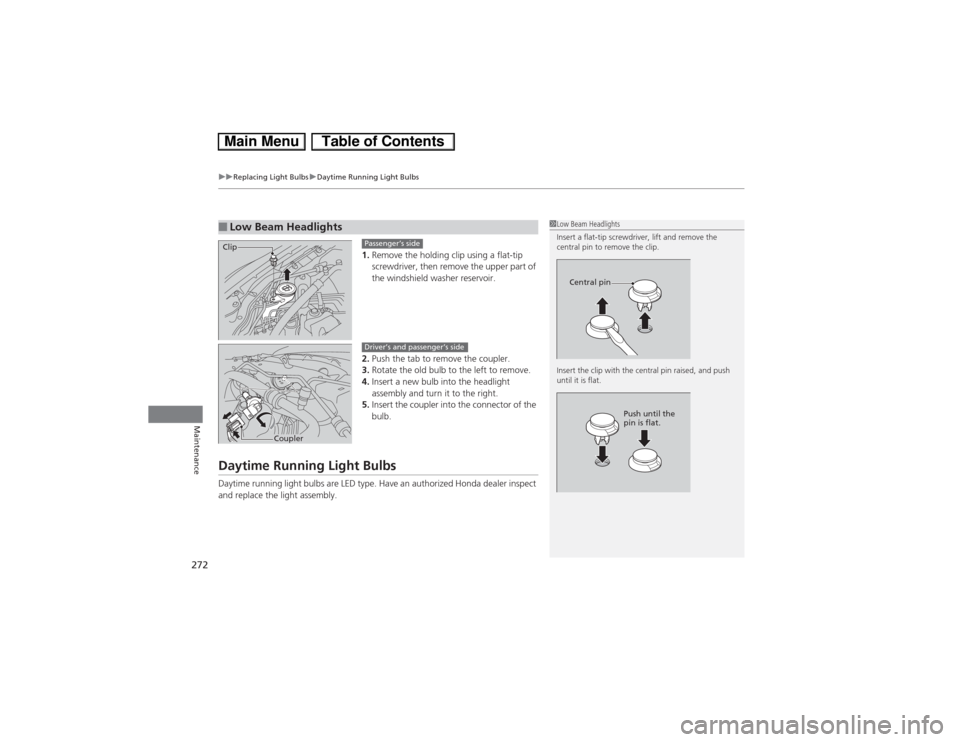
uuReplacing Light BulbsuDaytime Running Light Bulbs
272Maintenance
1.Remove the holding clip using a flat-tip
screwdriver, then remove the upper part of
the windshield washer reservoir.
2.Push the tab to remove the coupler.
3.Rotate the old bulb to the left to remove.
4.Insert a new bulb into the headlight
assembly and turn it to the right.
5.Insert the coupler into the connector of the
bulb.
Daytime Running Light BulbsDaytime running light bulbs are LED type. Have an authorized Honda dealer inspect
and replace the light assembly.■Low Beam Headlights
1Low Beam Headlights
Insert a flat-tip screwdriver, lift and remove the
central pin to remove the clip.
Insert the clip with the central pin raised, and push
until it is flat.
Central pin
Push until the
pin is flat.
Clip
Passenger’s side
Coupler
Driver’s and passenger’s side
Page 274 of 346
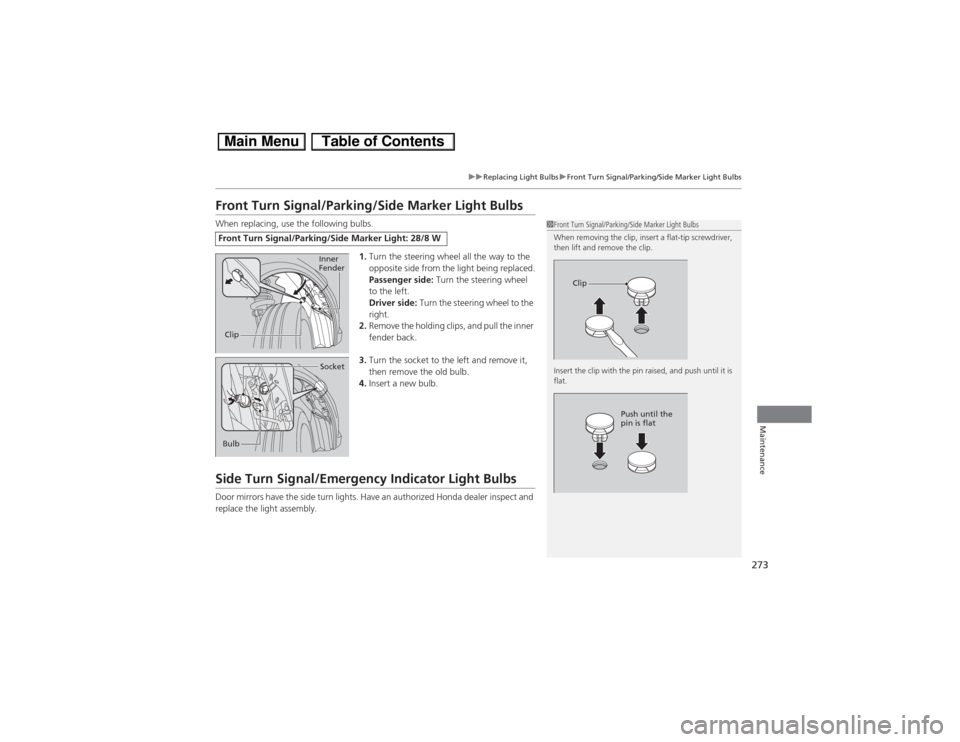
273
uuReplacing Light BulbsuFront Turn Signal/Parking/Side Marker Light Bulbs
Maintenance
Front Turn Signal/Parking/Side Marker Light BulbsWhen replacing, use the following bulbs.
1.Turn the steering wheel all the way to the
opposite side from the light being replaced.
Passenger side: Turn the steering wheel
to the left.
Driver side: Turn the steering wheel to the
right.
2.Remove the holding clips, and pull the inner
fender back.
3.Turn the socket to the left and remove it,
then remove the old bulb.
4.Insert a new bulb.Side Turn Signal/Emergency Indicator Light BulbsDoor mirrors have the side turn lights. Have an authorized Honda dealer inspect and
replace the light assembly.Front Turn Signal/Parking/Side Marker Light: 28/8 W
1Front Turn Signal/Parking/Side Marker Light Bulbs
When removing the clip, insert a flat-tip screwdriver,
then lift and remove the clip.
Insert the clip with the pin raised, and push until it is
flat.
Clip
Push until the
pin is flat
ClipInner
FenderBulbSocket
Page 275 of 346
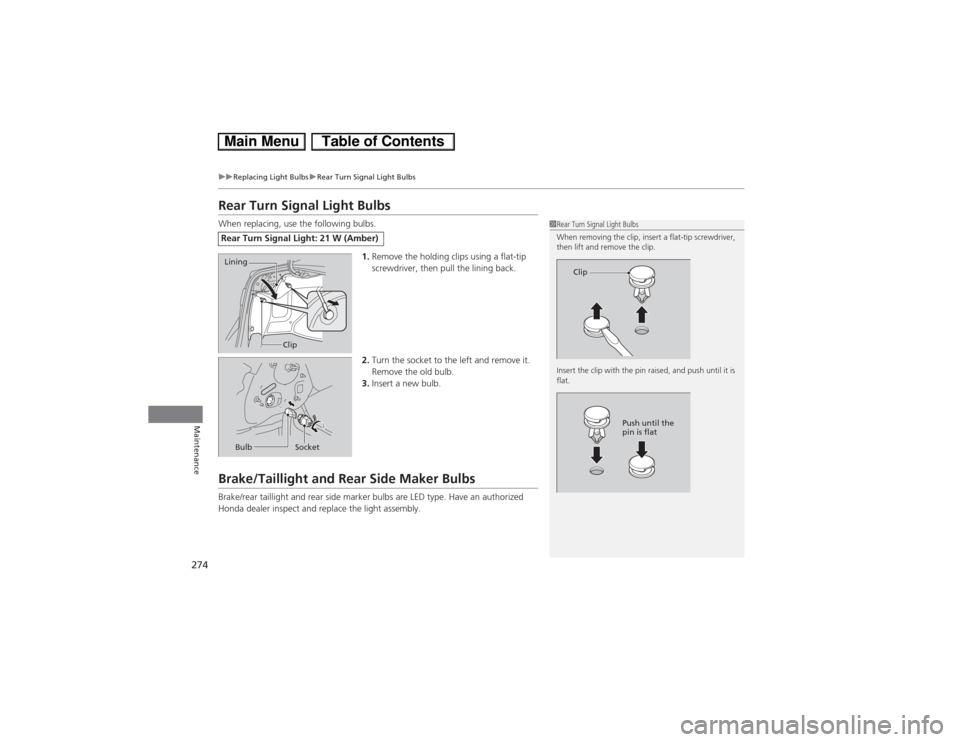
274
uuReplacing Light BulbsuRear Turn Signal Light Bulbs
Maintenance
Rear Turn Signal Light BulbsWhen replacing, use the following bulbs.
1.Remove the holding clips using a flat-tip
screwdriver, then pull the lining back.
2.Turn the socket to the left and remove it.
Remove the old bulb.
3.Insert a new bulb.Brake/Taillight and Rear Side Maker BulbsBrake/rear taillight and rear side marker bulbs are LED type. Have an authorized
Honda dealer inspect and replace the light assembly.Rear Turn Signal Light: 21 W (Amber)
1Rear Turn Signal Light Bulbs
When removing the clip, insert a flat-tip screwdriver,
then lift and remove the clip.
Insert the clip with the pin raised, and push until it is
flat.
Clip
Push until the
pin is flat
Lining
ClipBulb Socket
Page 276 of 346
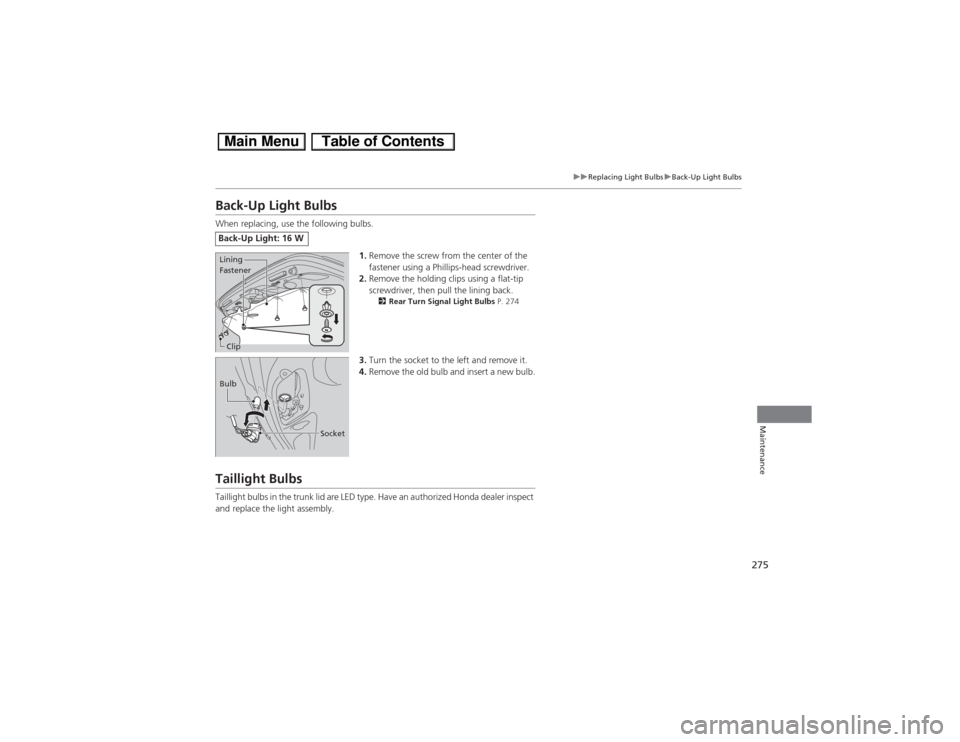
275
uuReplacing Light BulbsuBack-Up Light Bulbs
Maintenance
Back-Up Light BulbsWhen replacing, use the following bulbs.
1.Remove the screw from the center of the
fastener using a Phillips-head screwdriver.
2.Remove the holding clips using a flat-tip
screwdriver, then pull the lining back.
2Rear Turn Signal Light Bulbs P. 274
3.Turn the socket to the left and remove it.
4.Remove the old bulb and insert a new bulb.
Taillight BulbsTaillight bulbs in the trunk lid are LED type. Have an authorized Honda dealer inspect
and replace the light assembly.Back-Up Light: 16 WLining
Fastener
ClipBulb
Socket
Page 277 of 346
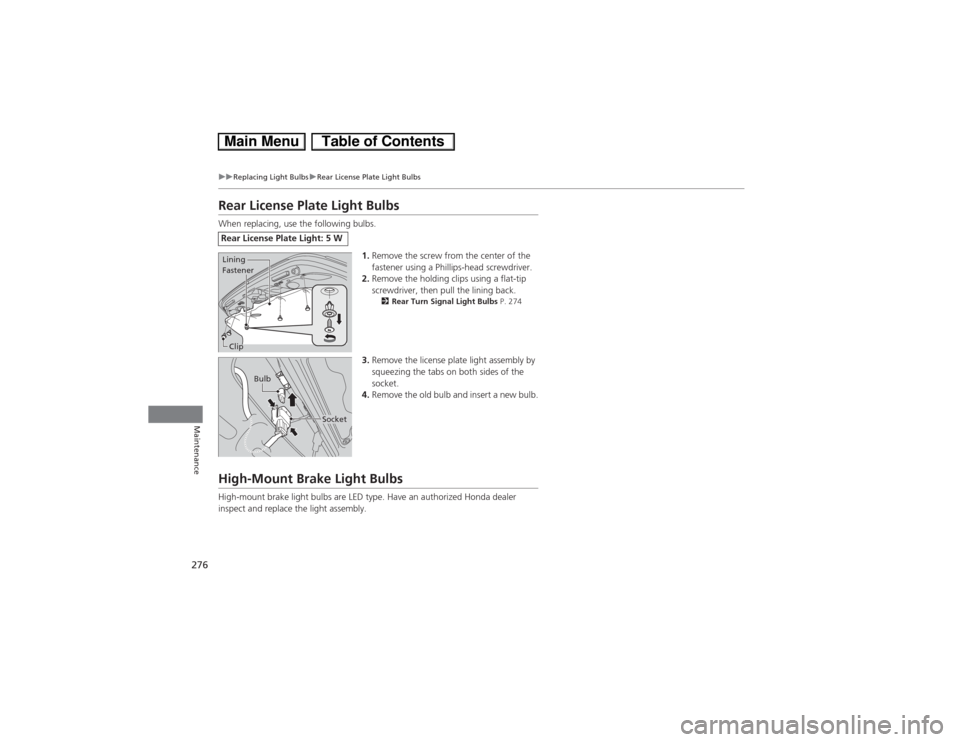
276
uuReplacing Light BulbsuRear License Plate Light Bulbs
Maintenance
Rear License Plate Light BulbsWhen replacing, use the following bulbs.
1.Remove the screw from the center of the
fastener using a Phillips-head screwdriver.
2.Remove the holding clips using a flat-tip
screwdriver, then pull the lining back.
2Rear Turn Signal Light Bulbs P. 274
3.Remove the license plate light assembly by
squeezing the tabs on both sides of the
socket.
4.Remove the old bulb and insert a new bulb.
High-Mount Brake Light BulbsHigh-mount brake light bulbs are LED type. Have an authorized Honda dealer
inspect and replace the light assembly.Rear License Plate Light: 5 W Lining
Fastener
Clip
Bulb
Socket
Page 278 of 346
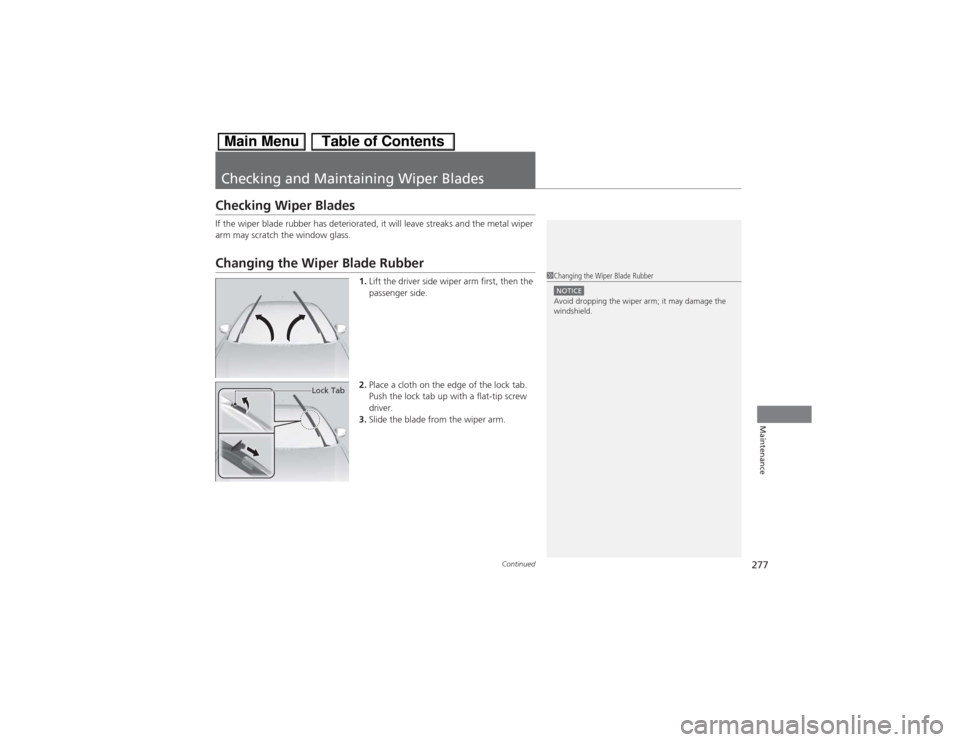
277
Continued
Maintenance
Checking and Maintaining Wiper BladesChecking Wiper BladesIf the wiper blade rubber has deteriorated, it will leave streaks and the metal wiper
arm may scratch the window glass.Changing the Wiper Blade Rubber
1.Lift the driver side wiper arm first, then the
passenger side.
2.Place a cloth on the edge of the lock tab.
Push the lock tab up with a flat-tip screw
driver.
3.Slide the blade from the wiper arm.
1Changing the Wiper Blade RubberNOTICEAvoid dropping the wiper arm; it may damage the
windshield.
Lock Tab
Page 279 of 346
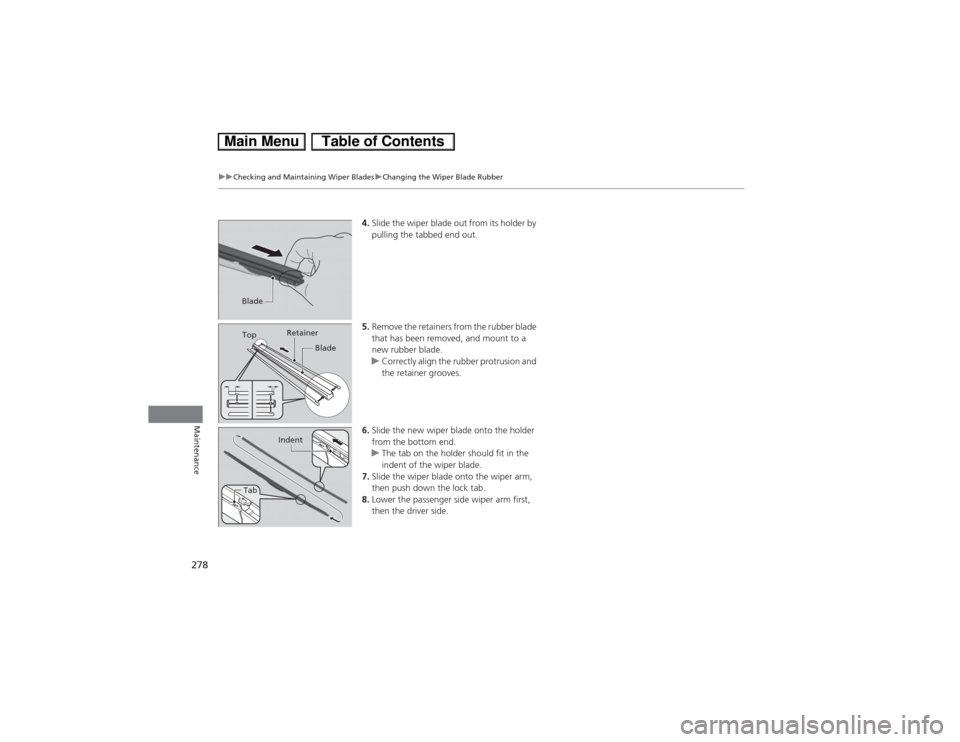
278
uuChecking and Maintaining Wiper BladesuChanging the Wiper Blade Rubber
Maintenance
4.Slide the wiper blade out from its holder by
pulling the tabbed end out.
5.Remove the retainers from the rubber blade
that has been removed, and mount to a
new rubber blade.
uCorrectly align the rubber protrusion and
the retainer grooves.
6.Slide the new wiper blade onto the holder
from the bottom end.
uThe tab on the holder should fit in the
indent of the wiper blade.
7.Slide the wiper blade onto the wiper arm,
then push down the lock tab.
8.Lower the passenger side wiper arm first,
then the driver side.
BladeTopRetainer
BladeTabIndent
Page 280 of 346
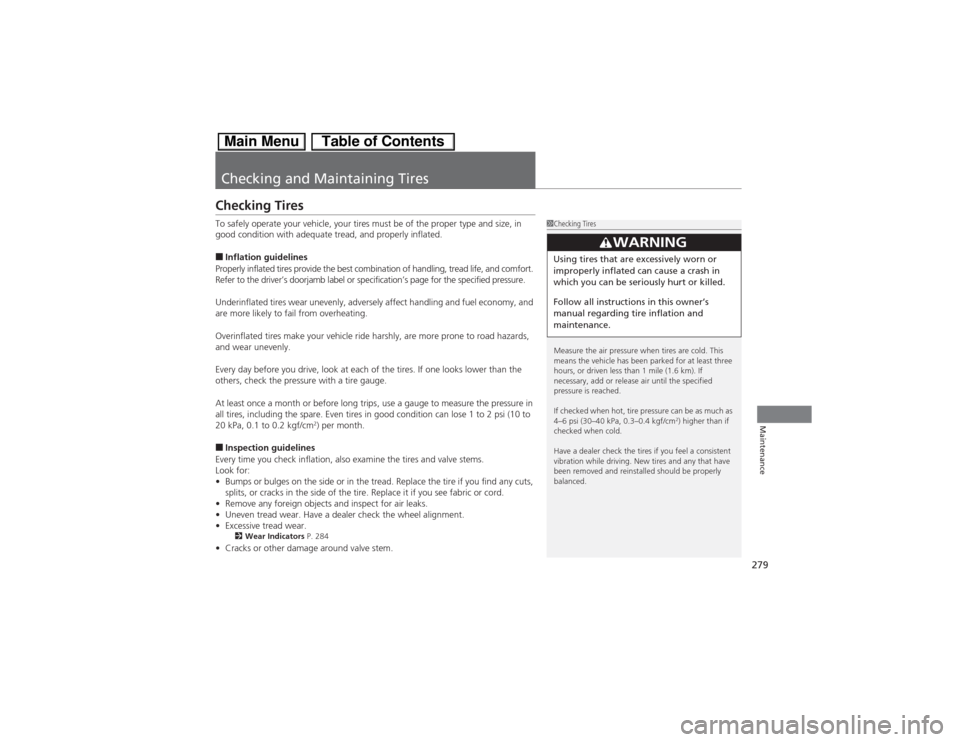
279Maintenance
Checking and Maintaining TiresChecking TiresTo safely operate your vehicle, your tires must be of the proper type and size, in
good condition with adequate tread, and properly inflated.■Inflation guidelines
Properly inflated tires provide the best combination of handling, tread life, and comfort.
Refer to the driver’s doorjamb label or specification’s page for the specified pressure.
Underinflated tires wear unevenly, adversely affect handling and fuel economy, and
are more likely to fail from overheating.
Overinflated tires make your vehicle ride harshly, are more prone to road hazards,
and wear unevenly.
Every day before you drive, look at each of the tires. If one looks lower than the
others, check the pressure with a tire gauge.
At least once a month or before long trips, use a gauge to measure the pressure in
all tires, including the spare. Even tires in good condition can lose 1 to 2 psi (10 to
20 kPa, 0.1 to 0.2 kgf/cm
2) per month.
■Inspection guidelines
Every time you check inflation, also examine the tires and valve stems.
Look for:
•Bumps or bulges on the side or in the tread. Replace the tire if you find any cuts,
splits, or cracks in the side of the tire. Replace it if you see fabric or cord.
•Remove any foreign objects and inspect for air leaks.
•Uneven tread wear. Have a dealer check the wheel alignment.
•Excessive tread wear.2Wear Indicators P. 284
•Cracks or other damage around valve stem.
1Checking Tires
Measure the air pressure when tires are cold. This
means the vehicle has been parked for at least three
hours, or driven less than 1 mile (1.6 km). If
necessary, add or release air until the specified
pressure is reached.
If checked when hot, tire pressure can be as much as
4–6 psi (30–40 kPa, 0.3–0.4 kgf/cm
2) higher than if
checked when cold.
Have a dealer check the tires if you feel a consistent
vibration while driving. New tires and any that have
been removed and reinstalled should be properly
balanced.
3
WARNING
Using tires that are excessively worn or
improperly inflated can cause a crash in
which you can be seriously hurt or killed.
Follow all instructions in this owner’s
manual regarding tire inflation and
maintenance.